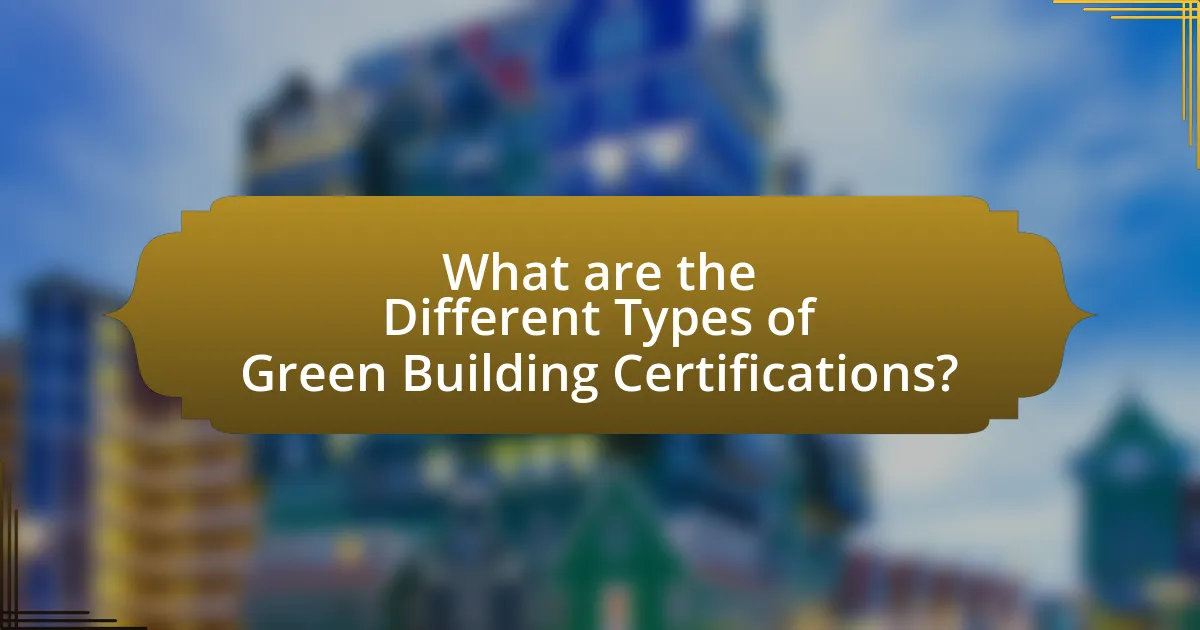Green Building Certifications, such as LEED and BREEAM, are formal recognitions that signify a building’s compliance with environmentally sustainable practices. These certifications influence structural design by establishing criteria for energy efficiency, water conservation, and material sustainability, which architects and engineers must integrate into their projects. Key criteria for obtaining these certifications include sustainable site development, energy efficiency, and indoor environmental quality, all of which impact the design process and market value of buildings. The growing importance of these certifications is driven by increasing environmental awareness, regulatory pressures, and the tangible benefits they offer, such as reduced operational costs and enhanced occupant health.

What are Green Building Certifications and their Importance?
Green Building Certifications are formal recognitions that indicate a building’s adherence to environmentally sustainable practices and standards. These certifications, such as LEED (Leadership in Energy and Environmental Design) and BREEAM (Building Research Establishment Environmental Assessment Method), assess various aspects of a building’s design, construction, and operation, including energy efficiency, water usage, and material sustainability. The importance of these certifications lies in their ability to promote energy conservation, reduce greenhouse gas emissions, and enhance occupant health and well-being. For instance, buildings with LEED certification can achieve energy savings of 30% to 50% compared to conventional buildings, demonstrating their significant impact on reducing environmental footprints.
How do Green Building Certifications influence structural design?
Green Building Certifications significantly influence structural design by establishing specific sustainability criteria that must be met during the design and construction phases. These certifications, such as LEED and BREEAM, require the integration of energy-efficient materials, sustainable construction practices, and innovative design strategies that minimize environmental impact. For instance, LEED certification encourages the use of recycled materials and energy-efficient systems, which directly affects the choice of structural components and overall design approach. This influence is evident in the increased adoption of advanced materials like high-performance concrete and steel, which enhance durability while reducing resource consumption.
What are the key criteria for obtaining Green Building Certifications?
The key criteria for obtaining Green Building Certifications include sustainable site development, water efficiency, energy efficiency, materials selection, and indoor environmental quality. Sustainable site development focuses on minimizing the environmental impact of the building’s location and construction, while water efficiency emphasizes reducing water usage and promoting conservation. Energy efficiency criteria require the building to use less energy through efficient systems and renewable energy sources. Materials selection involves using sustainable, recycled, or locally sourced materials to reduce the carbon footprint. Lastly, indoor environmental quality ensures that the building provides a healthy environment for occupants through proper ventilation, lighting, and materials that do not emit harmful pollutants. These criteria are validated by certification programs such as LEED, which has specific point systems to assess compliance with these standards.
How do these criteria impact the design process?
Green building certification criteria significantly influence the design process by establishing specific sustainability benchmarks that must be met. These criteria guide architects and engineers in selecting materials, optimizing energy efficiency, and ensuring water conservation, which ultimately shapes the overall design strategy. For instance, the Leadership in Energy and Environmental Design (LEED) certification requires adherence to standards that promote the use of renewable resources and minimize environmental impact, compelling designers to innovate and integrate sustainable practices into their projects. This structured approach not only enhances the building’s performance but also aligns with regulatory requirements and market demand for environmentally responsible construction.
Why are Green Building Certifications becoming essential in construction?
Green Building Certifications are becoming essential in construction due to their role in promoting sustainability and energy efficiency. These certifications, such as LEED and BREEAM, provide a framework for evaluating the environmental performance of buildings, leading to reduced energy consumption, lower greenhouse gas emissions, and improved indoor air quality. According to the U.S. Green Building Council, buildings certified under LEED can achieve energy savings of 30% to 50% compared to conventional buildings, demonstrating the tangible benefits of these certifications. As regulatory pressures and public demand for sustainable practices increase, the adoption of Green Building Certifications is critical for aligning construction practices with environmental goals.
What trends are driving the adoption of Green Building Certifications?
The adoption of Green Building Certifications is primarily driven by increasing environmental awareness and regulatory pressures. As climate change concerns escalate, stakeholders in the construction industry are prioritizing sustainable practices, leading to a rise in demand for certified green buildings. For instance, a report by the World Green Building Council indicates that green buildings can reduce energy consumption by up to 50% compared to traditional buildings, highlighting the economic and environmental benefits that drive this trend. Additionally, government incentives and policies aimed at promoting sustainability further encourage the adoption of these certifications, making them a critical factor in modern structural design.
How do certifications affect market value and building performance?
Certifications significantly enhance market value and building performance by demonstrating compliance with sustainability standards. Buildings with certifications such as LEED or BREEAM often command higher rental rates and sale prices, as evidenced by a study from the U.S. Green Building Council, which found that LEED-certified buildings can achieve a price premium of up to 30% compared to non-certified counterparts. Additionally, these certifications lead to improved energy efficiency and reduced operational costs, contributing to better overall performance. Research published in the Journal of Sustainable Real Estate indicates that certified buildings typically experience lower vacancy rates and higher tenant satisfaction, further solidifying their market value.

What are the Different Types of Green Building Certifications?
The different types of green building certifications include LEED (Leadership in Energy and Environmental Design), BREEAM (Building Research Establishment Environmental Assessment Method), and ENERGY STAR. LEED, developed by the U.S. Green Building Council, evaluates buildings based on sustainable site development, water savings, energy efficiency, materials selection, and indoor environmental quality. BREEAM, originating in the UK, assesses the sustainability of buildings through a similar framework, focusing on energy, health, and pollution. ENERGY STAR, a program by the U.S. Environmental Protection Agency, specifically targets energy efficiency in buildings. These certifications are recognized globally and provide a standardized approach to evaluating the environmental performance of buildings, thereby influencing structural design practices to prioritize sustainability.
How do various certifications differ in their requirements?
Various certifications differ in their requirements primarily based on the specific criteria they assess, the level of documentation needed, and the performance metrics they mandate. For instance, the Leadership in Energy and Environmental Design (LEED) certification emphasizes energy efficiency, sustainable site development, and indoor environmental quality, requiring extensive documentation and third-party verification. In contrast, the Building Research Establishment Environmental Assessment Method (BREEAM) focuses on a broader range of sustainability issues, including management processes and health and well-being, with a different scoring system that may require less documentation for certain credits. Additionally, the National Green Building Standard (NGBS) offers a more flexible approach, allowing for various compliance paths that can cater to different project types and budgets. These differences illustrate how each certification has unique requirements tailored to its specific sustainability goals and assessment methodologies.
What are the most recognized Green Building Certification programs?
The most recognized Green Building Certification programs include LEED (Leadership in Energy and Environmental Design), BREEAM (Building Research Establishment Environmental Assessment Method), and the Living Building Challenge. LEED, developed by the U.S. Green Building Council, is widely adopted in North America and emphasizes energy efficiency, sustainable site development, and water conservation. BREEAM, originating in the UK, assesses the sustainability of buildings based on various criteria, including energy use and ecological impact. The Living Building Challenge is known for its rigorous standards, requiring buildings to be self-sufficient and have a positive impact on the environment. These certifications are validated by their widespread use in the industry and their influence on sustainable building practices globally.
How does each certification program impact structural design choices?
Each green building certification program impacts structural design choices by establishing specific criteria that influence material selection, energy efficiency, and sustainability practices. For instance, the Leadership in Energy and Environmental Design (LEED) certification encourages the use of sustainable materials and energy-efficient systems, prompting designers to prioritize renewable resources and innovative technologies. Similarly, the Building Research Establishment Environmental Assessment Method (BREEAM) emphasizes the importance of minimizing environmental impact, which can lead to the adoption of advanced structural systems that reduce carbon footprints. These certifications guide architects and engineers in making informed decisions that align with environmental goals, ultimately shaping the structural integrity and sustainability of buildings.
What role do local regulations play in Green Building Certifications?
Local regulations significantly influence Green Building Certifications by establishing the baseline requirements for sustainability and energy efficiency in construction. These regulations often dictate specific standards that buildings must meet to qualify for certification, such as energy performance benchmarks, water conservation measures, and materials sourcing guidelines. For instance, jurisdictions may adopt codes that align with LEED (Leadership in Energy and Environmental Design) or other certification systems, ensuring that local developments adhere to recognized sustainability practices. This alignment not only promotes environmental responsibility but also enhances the marketability of certified buildings, as compliance with local regulations often leads to incentives like tax breaks or expedited permitting processes.
How do building codes influence certification requirements?
Building codes significantly influence certification requirements by establishing the minimum safety, health, and environmental standards that structures must meet. These codes dictate specific criteria for materials, construction practices, and energy efficiency, which directly align with the prerequisites for various green building certifications, such as LEED or BREEAM. For instance, the International Building Code (IBC) outlines structural integrity and safety measures that must be adhered to, which in turn affects the eligibility for certifications that promote sustainable practices. Compliance with these codes ensures that certified buildings not only meet regulatory standards but also contribute to energy conservation and reduced environmental impact, reinforcing the importance of integrating building codes into the certification process.
What are the implications of non-compliance with local regulations?
Non-compliance with local regulations can lead to significant legal and financial repercussions for construction projects. Entities that fail to adhere to these regulations may face fines, legal action, or even the halting of construction activities. For instance, a study by the National Institute of Building Sciences indicates that non-compliance can result in penalties that range from thousands to millions of dollars, depending on the severity of the violation. Additionally, non-compliance can jeopardize the safety and integrity of the structure, leading to potential liability issues if the building fails to meet safety standards. This underscores the importance of adhering to local regulations in the context of green building certifications and structural design.

What are the Challenges and Opportunities in Implementing Green Building Certifications?
Implementing green building certifications presents challenges such as high initial costs, complexity in compliance, and a lack of skilled professionals. These factors can deter stakeholders from pursuing certification, as the financial investment and technical knowledge required may seem daunting. However, opportunities include long-term cost savings through energy efficiency, increased property value, and enhanced marketability. Research indicates that buildings with green certifications can achieve energy savings of 30% to 50%, which can offset initial costs over time. Additionally, the growing demand for sustainable buildings creates a competitive advantage for certified structures, making them more attractive to environmentally conscious consumers.
What are the common challenges faced by architects and engineers?
Architects and engineers commonly face challenges such as regulatory compliance, budget constraints, and coordination among multidisciplinary teams. Regulatory compliance involves navigating complex building codes and environmental regulations, which can vary significantly by location and impact project timelines. Budget constraints often limit the materials and technologies that can be utilized, forcing professionals to find cost-effective solutions without compromising quality. Coordination among multidisciplinary teams is essential for successful project execution, yet it can be hindered by communication gaps and differing priorities, leading to delays and conflicts. These challenges are critical in the context of green building certifications, which require adherence to specific sustainability standards that further complicate the design and construction processes.
How can these challenges be overcome in the design phase?
Challenges in the design phase can be overcome by integrating sustainable practices and utilizing advanced technologies. Implementing early-stage collaboration among architects, engineers, and sustainability consultants ensures that green building certifications are prioritized from the outset. For instance, using Building Information Modeling (BIM) allows for real-time analysis of design choices against certification requirements, facilitating informed decision-making. Research from the U.S. Green Building Council indicates that projects designed with integrated teams achieve certification goals more efficiently, reducing rework and enhancing compliance with sustainability standards.
What resources are available to assist in meeting certification standards?
Resources available to assist in meeting certification standards include guidelines from organizations such as the U.S. Green Building Council (USGBC), which provides the LEED certification framework, and the International Living Future Institute, which offers the Living Building Challenge. These organizations supply comprehensive documentation, training programs, and online tools to help professionals understand and implement the necessary criteria for certification. Additionally, industry-specific publications and workshops can provide insights into best practices and case studies that demonstrate successful compliance with certification standards.
What opportunities do Green Building Certifications present for innovation?
Green Building Certifications present significant opportunities for innovation by encouraging the development of sustainable materials and advanced construction techniques. These certifications, such as LEED and BREEAM, drive architects and builders to explore innovative solutions that reduce environmental impact, enhance energy efficiency, and improve indoor air quality. For instance, the demand for certified buildings has led to the creation of new eco-friendly materials, such as recycled steel and low-VOC paints, which are now widely adopted in the industry. Additionally, the integration of smart technologies in certified buildings, like energy management systems, exemplifies how these certifications stimulate technological advancements. According to a study by the World Green Building Council, buildings with green certifications can achieve energy savings of up to 30%, showcasing the tangible benefits of innovation spurred by these standards.
How can sustainable materials and technologies enhance structural design?
Sustainable materials and technologies enhance structural design by improving resource efficiency, reducing environmental impact, and increasing the longevity of structures. For instance, using recycled steel and bamboo as building materials can significantly lower carbon emissions compared to traditional materials like concrete. Additionally, technologies such as Building Information Modeling (BIM) facilitate better planning and resource management, leading to optimized designs that minimize waste. Research indicates that buildings designed with sustainable practices can achieve energy savings of up to 30% over their lifecycle, demonstrating the effectiveness of these materials and technologies in enhancing structural integrity and sustainability.
What are the long-term benefits of investing in Green Building Certifications?
Investing in Green Building Certifications yields long-term benefits such as reduced operational costs, increased property value, and enhanced occupant health. These certifications often lead to energy-efficient designs that lower utility expenses; for instance, buildings with LEED certification can achieve energy savings of 30% or more compared to conventional buildings. Additionally, properties with Green Building Certifications typically see a higher market value, with studies indicating a price premium of 7% to 10% for certified buildings. Furthermore, these certifications promote healthier indoor environments, which can improve occupant productivity and reduce healthcare costs associated with poor air quality.
What are the best practices for integrating Green Building Certifications into structural design?
The best practices for integrating Green Building Certifications into structural design include early collaboration among stakeholders, adherence to certification guidelines, and the use of sustainable materials. Early collaboration ensures that architects, engineers, and contractors align their goals with certification requirements, facilitating a cohesive design approach. Adhering to certification guidelines, such as those from LEED or BREEAM, provides a framework for energy efficiency, water conservation, and indoor environmental quality. Utilizing sustainable materials, such as recycled steel or certified wood, not only meets certification criteria but also reduces the environmental impact of the structure. These practices are supported by studies indicating that projects designed with these principles can achieve higher certification levels and improve overall building performance.

Leave a Reply